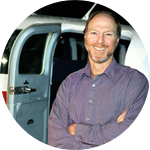Project Results
About This Project
There is a proposal to significantly increase the number of trains carrying coal through Washington State, but at present little is known about the likely health impacts from this plan. Our project will examine air quality for people living near the tracks for both fine particulate (diesel) and larger particles that may be associated with coal dust. Phase 1 was completed last year. Phase 2 takes place in Fall 2014 in Bellingham (campaign here).Ask the Scientists
Join The DiscussionWhat is the context of this research?
Quantify the emissions and particulate matter concentrations by train type (passenger, freight, coal) for a 4 week period during the Fall of 2014 This information is needed to assess the air quality impacts associated with trains in the Puget Sound region.
What is the significance of this project?
Trains are a fuel efficient way to move freight and people. Yet diesel trains leave behind a trail of exhaust that may be hazardous for people living near the tracks. Coal trains may also leave behind a trail of fine coal dust in the air that is hazardous to breathe. In Washington State, there are proposals to substantially increase the number of trains carrying coal through our region. Yet we know almost nothing about the impact these trains will have on air quality along the rail lines. Before these decisions are made, it is essential to gather high quality scientific data on the impacts trains currently have on air quality in the region so that we can accurately forecast the environmental impact the increased train traffic would have on our region.
What are the goals of the project?
The funds will be used to purchase equipment, pay students and a technician to collect and analyze the data.
Specifically, we will install an air quality monitor (TSI DustTrak DRX 8533) that can simultaneously measure in four size “bins” (1µm, 2.5 µm, 10 µm and total suspended particulate). The size distribution will help separate out the influence of diesel exhaust from coal dust, which generates particles that have larger diameters. We will install the instrument at a location in Bellingham. We will also install met sensors (T, RH, wind speed and direction) and a web camera to identify the types of trains that are going by. All instruments will be housed in a small waterproof housing.
Budget
The funds will be used for equipment (met station, laptop and adapters), a technician and students to setup, collect and analyze the data.
Meet the Team
Affiliates
Ph.D. Chemistry, University of Washington,. 1987.
Team Bio
I am a Professor at the University of Washington and an expert on air quality. My research team has published over 100 scientific papers and conducted dozens of air quality studies in the Pacific Northwest and around the globe with funding from NSF, NASA, NOAA, etc. I have participated on review and advisory panels for the NSF, NASA, EPA, NOAA and the National Academy of Sciences and my work is widely cited in the scientific literature. Learn more about my research here. I also have a previous study of air quality in the Columbia River Gorge: http://www.atmos-chem-phys.net/9/7997/2009/acp-9-7997-2009.htmlDan Jaffe
I am a Professor at the University of Washington and an expert on air quality. My research team has published over 100 scientific papers and conducted dozens of air quality studies in the Pacific Northwest and around the globe with funding from NSF, NASA, NOAA, etc. I have participated on review and advisory panels for the NSF, NASA, EPA, NOAA and the National Academy of Sciences and my work is widely cited in the scientific literature. Learn more about my research here. I also have a previous study of air quality in the Columbia River Gorge: http://www.atmos-chem-phys.net/9/7997/2009/acp-9-7997-2009.html
Press and Media
Phase 1 work was published. See: www.atmospolres.com/articles/Volume5/issue2/APR-14-040.pdfAdditional Information
Deliverables:A final technical project report will document PM exposure by size distribution at the monitoring site and will be submitted to a scientific journal for review and publication. We will classify this exposure by train type (passenger, freight, coal). We will also generate an executive summary of our report that can be read and interpreted by the general public and decision makers. Both reports will be completed within 9 months of project start date We need to know what will be the likely air quality and human health impacts from trains in our region before making decisions on shipping coal by rail thru the region. Unfortunately none of the federal, state or local agencies are able to fund or support this work for political reasons. Yet it has to be done! Please help us collect this critical scientific data. Dan
Press
DEPTS.WASHINGTON.EDU
Atmospheric chemist’s crowdfunding appeal breaks record
KUOW.ORG
The Tribes And Same-Sex Marriage, Science News, And Beverly Washburn
OREGONLIVE.ORG
UW chemist says 'All aboard' for coal train fight: 200 wiseguy words
SEATTLETIMES.COM
UW chemist’s coal project gets crowdfunded — in record time
SEATTLETIMES.COM
Coal trains fire up UW chemist
NWPR.ORG
Crowdfunding Coal Science
EARTHFIX.OPB.ORG
Crowdfunding Coal Science
EENEWS.NET
Combatants start 'huge, multidimensional chess game' over Northwest exports
Project Backers
- 271Backers
- 114%Funded
- $20,529Total Donations
- $75.47Average Donation
